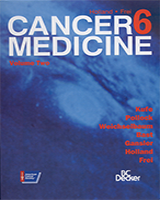By agreement with the publisher, this book is accessible by the search feature, but cannot be browsed.
NCBI Bookshelf. A service of the National Library of Medicine, National Institutes of Health.
Kufe DW, Pollock RE, Weichselbaum RR, et al., editors. Holland-Frei Cancer Medicine. 6th edition. Hamilton (ON): BC Decker; 2003.

Holland-Frei Cancer Medicine. 6th edition.
Show detailsSubstantial and convincing bodies of experimental, clinical, and epidemiologic evidence indicate that hormones play a major role in the etiology of several human cancers. The concept that hormones can increase the incidence of neoplasia was first proposed by Bittner,1 on the basis of experimental studies of estrogens and mammary cancer in mice. This theory has been refined into epidemiologic hypotheses related to cancers of the breast, endometrium, prostate, ovary, thyroid, bone, and testis.2,3 The underlying mechanism proposed for all of these cancers is that neoplasia is the consequence of prolonged hormonal stimulation of the particular target organ, the normal growth and function of which is controlled by one or more steroid or polypeptide hormones. Evidence is mounting to show that the amount of hormone to which a tissue is effectively exposed is under strong genetic control.4 Therefore, although external factors such as diet or exogenous hormone use may modify hormone profiles, the current evidence supports a multigenic model of cancer susceptibility where sequence variants in genes encoding proteins involved in steroid-hormone biosynthesis, metabolism or intracellular signaling and transport, and deoxyribonucleic acid (DNA) binding, repair, and transactivation are also important determinants of individual cancer risk.4,5
The major carcinogenic consequence of this hormonal exposure at the end organ is cellular proliferation. The emergence of a malignant phenotype depends on a series of somatic mutations that occur during cell division but the entire sequence of genes involved in progression from normal cell to a particular malignant phenotype is not known (Figure 18-1). Candidate genes include those in the endocrine and growth factor pathways,4–6 as well as DNA repair genes, tumor-suppressor genes, and oncogenes.7,8 Germ line mutations have been described in two such tumor-suppressor genes, BRCA1 and BRCA2, that are associated with susceptibility to breast cancer in certain kindreds.9,10 Germ line mutations in TP53 are also associated in certain kindreds with an increased risk of breast cancer.11 However, mutations in these genes do not appear to be involved in the majority of sporadic breast cancer. The HER2/neu oncogene is overexpressed in advanced breast cancer, is associated with poor prognosis, and probably represents one critical event in the latter part of breast cancer progression.12

Figure 18-1
Estradiol and, other steroid hormones (eg, progesterone) drive breast cell proliferation, which facilitates the accumulation of random DNA copying errors in critical genes on the pathway to a malignant phenotype. Germ line mutations in relevant tumor-suppressor (more...)
Neoplasia of hormone-responsive tissues currently accounts for more than 35% of all newly diagnosed male and almost 50% of all newly diagnosed female cancers in the United States. Given that endogenous hormones apparently affect the risk of these cancers and their overall frequency, concern exists about the effects on cancer risk if the same or closely related hormones are administered for therapeutic purposes (eg, as contraceptives, as hormone replacement therapy, or for the prevention of miscarriage).13 This chapter provides a review of the epidemiologic and endocrinologic evidence for the role of hormones in the development of specific cancers as well as the current status of the relationship between exogenous hormones and cancers of the breast, endometrium, and ovary.
Contents
- Breast Cancer
- Endometrial Cancer
- Ovarian Cancer
- Prostate Cancer
- Adolescent and Young Adult Genital Cancer
- Cervical Cancer
- Thyroid Cancer
- Osteosarcoma
- Conclusion
- References
- Hormones and the Etiology of Cancer - Holland-Frei Cancer MedicineHormones and the Etiology of Cancer - Holland-Frei Cancer Medicine
- Rat helix-destabilizing protein mRNA, complete cdsRat helix-destabilizing protein mRNA, complete cdsgi|204579|gb|M12156.1|RATHDPNucleotide
- R.norvegicus mRNA for serine/threonine kinase MARK2R.norvegicus mRNA for serine/threonine kinase MARK2gi|2052190|emb|Z83869.1|Nucleotide
Your browsing activity is empty.
Activity recording is turned off.
See more...